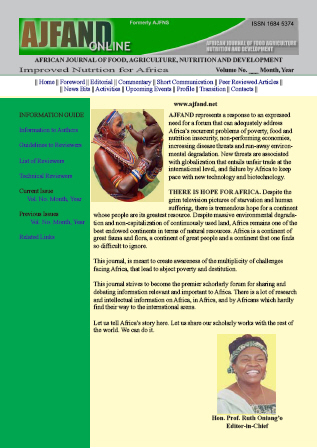
|
African Journal of Food, Agriculture, Nutrition and Development
Rural Outreach Program
ISSN: 1684-5358
EISSN: 1684-5358
Vol. 18, No. 3, 2018, pp. 13808-13824
|
 Bioline Code: nd18066
Bioline Code: nd18066
Full paper language: English
Document type: Research Article
Document available free of charge
|
|
|
African Journal of Food, Agriculture, Nutrition and Development, Vol. 18, No. 3, 2018, pp. 13808-13824
| en |
EVALUATION OF MYCOTOXIN CONTENT IN SOYBEAN ( Glycine max  L.) GROWN IN RWANDA L.) GROWN IN RWANDA
Niyibituronsa, M; Onyango, AN; Gaidashova, S; Imathiu, SM; Uwizerwa, M; Wanjuki, I; Nganga, F; Muhutu, JC; Birungi, J; Ghimire, S; Raes, K; De Boevre, M; De Saeger, S & Harvey, J
Abstract
Soybean is a critical food and nutritional security crop in Rwanda. Promoted by the
Rwandan National Agricultural Research System for both adults and as an infant
weaning food, soybean is grown by approximately 40% of households. Soybean may be
susceptible to the growth of mycotoxin-producing moulds; however, data has been
contradictory. Mycotoxin contamination is a food and feed safety issue for grains and
other field crops. This study aimed to determine the extent of mycotoxin contamination
in soybean, and to assess people’s awareness on mycotoxins. A farm-level survey was
conducted in 2015 within three agro-ecological zones of Rwanda suitable for soybean
production. Soybean samples were collected from farmers (n=300) who also completed
questionnaires about pre-and post-harvest farm practices, and aflatoxin awareness. The
concentration of total aflatoxin in individual soybean samples was tested by enzyme-linked
immunosorbent assay (ELISA) using a commercially-available kit. Other
mycotoxins were analyzed using liquid chromatography-mass spectrometry (LC-MS/MS) on 10 selected sub samples. Only 7.3% of the respondents were aware of
aflatoxin contamination in foods, but farmers observed good postharvest practices
including harvesting the crop when the pods were dry. Using enzyme-linked
immunosorbent assay (ELISA), only one sample had a concentration (11 μg/kg) above
the most stringent EU maximum permitted limit of 4 μg/kg. Multi-mycotoxins liquid
chromatography-mass spectrometry (LC-MS/MS) results confirmed that soybeans had
low or undetectable contamination; only one sample contained 13μg/kg of
sterigmatocystine. The soybean samples from Rwanda obtained acceptably low
mycotoxin levels. Taken together with other studies that showed that soybean is less
contaminated by mycotoxins, these results demonstrate that soybean can be promoted as
a nutritious and safe food. However, there is a general need for educating farmers on
mycotoxin contamination in food and feed to ensure better standards are adhered to
safeguard the health of the consumers regarding these fungal secondary metabolites.
Keywords
soybean; safety; mould; aflatoxin; mycotoxins; sterigmatocystine; ELISA; LC-MS/MS; Rwanda
|
| |
© Copyright 2018 - African Journal of Food, Agriculture, Nutrition and Development
Alternative site location: http://www.ajfand.net/
|
|
